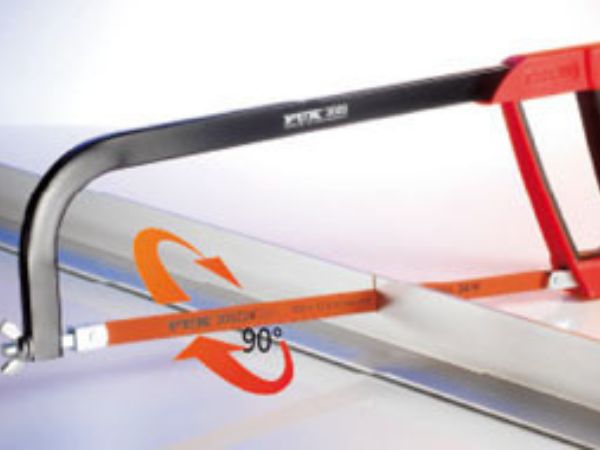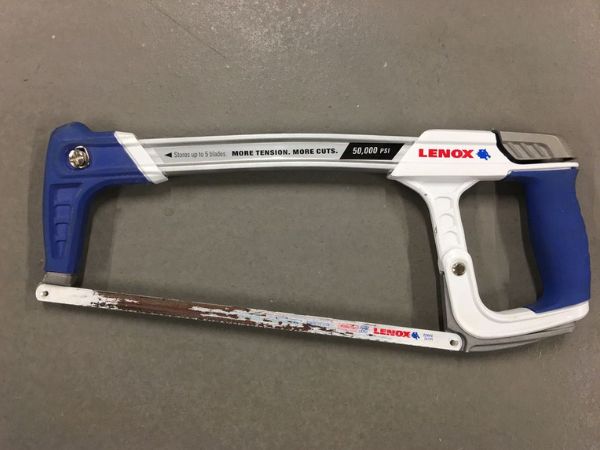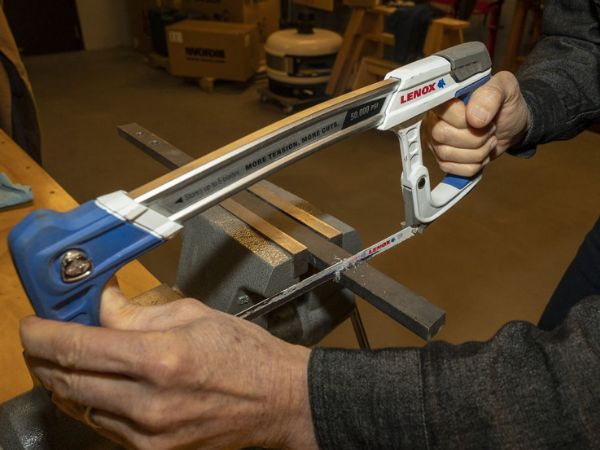Can A Hacksaw Cut Metal – Ultimate Guide

Auto Amazon Links: No products found.
Hacksaws are versatile hand tools commonly used for cutting various materials, including metal. They consist of a frame, known as a hacksaw frame, and a replaceable blade. Hacksaws are known for their ability to make precise cuts, making them a popular choice in many industries and applications. Can A Hacksaw Cut Metal.……
Contents
- 1 Understanding the Basics of Hacksaws
- 2 What is the Purpose of a Hacksaw?
- 3 Types of Hacksaw Blades for Metal Cutting
- 4 Can a Hacksaw Cut Metal?
- 5 Advantages of Using a Hacksaw for Metal Cutting
- 6 Factors to Consider When Using a Hacksaw on Metal
- 7 Choosing the Right Hacksaw Blade for Metal Cutting
- 8 Proper Technique for Using a Hacksaw on Metal
- 9 Safety Precautions When Cutting Metal with a Hacksaw
- 10 Common Mistakes to Avoid When Using a Hacksaw on Metal
- 11 Tips for Efficient and Effective Metal Cutting with a Hacksaw
- 12 Using a Hacksaw vs. Other Metal Cutting Tools
- 13 Limitations of Hacksaws in Metal Cutting
- 14 When to Choose a Hacksaw for Metal Cutting
- 15 Applications and Industries Where Hacksaws are Commonly Used for Metal Cutting
- 16 Maintaining and Caring for Hacksaw Blades for Metal Cutting
- 17 Enhancing Precision and Accuracy When Using a Hacksaw on Metal
- 18 Advancements in Hacksaw Technology for Metal Cutting
- 19 Conclusion: Can a Hacksaw Successfully Cut Metal?
- 20 FAQs:
Understanding the Basics of Hacksaws
A hacksaw consists of a U-shaped frame with a handle on one end and a blade attached to the other end. The frame holds the blade in place and provides stability during cutting. The blade is designed to have fine teeth, allowing it to cut through different materials with precision.
What is the Purpose of a Hacksaw?
The primary purpose of a hacksaw is to cut through various materials, including metal. It is often used in applications where a power saw or other cutting tools may not be practical or available. Hacksaws are particularly useful for cutting metal pipes, rods, and other similar objects.
Types of Hacksaw Blades for Metal Cutting
Hacksaw blades come in different types, each designed for specific cutting applications. When it comes to cutting metal, the most common types of blades are high-speed steel (HSS) and bi-metal blades. HSS blades are made from a hardened type of steel and are suitable for cutting softer metals. Bi-metal blades, on the other hand, have a combination of high-speed steel teeth and a flexible, durable backing, making them ideal for cutting through tougher metals,
Can a Hacksaw Cut Metal?
Yes, a hacksaw can cut metal effectively. With the right blade and proper technique, a hacksaw can make clean and precise cuts on various types of metal. However, it is important to consider the thickness and hardness of the metal being cut, as well as the type of hacksaw blade being used.
Advantages of Using a Hacksaw for Metal Cutting
Using a hacksaw for metal cutting offers several advantages. First, hacksaws are relatively inexpensive compared to power saws, making them a cost-effective choice for many applications. Additionally, hacksaws are portable and do not require electricity, allowing for greater flexibility and accessibility. Hacksaws also provide greater control and precision, making them suitable for intricate cutting tasks.

Factors to Consider When Using a Hacksaw on Metal
When using a hacksaw for cutting metal, there are several factors to consider. The hardness and thickness of the metal will determine the type of blade and the amount of effort required. Thicker and harder metals may require a more durable and aggressive blade. The speed and pressure applied during cutting, as well as the angle at which the blade contacts the metal, will also affect the cutting process.
Choosing the Right Hacksaw Blade for Metal Cutting
Selecting the appropriate hacksaw blade for metal cutting is crucial for achieving clean and efficient cuts. As mentioned earlier, HSS blades are suitable for cutting softer metals, while bi-metal blades are more appropriate for tougher metals. It is essential to match the blade’s tooth pitch to the thickness of the metal being cut. Finer teeth are generally used for thin metals, while coarser teeth are better suited for thicker metals.
Proper Technique for Using a Hacksaw on Metal
To achieve optimal results when cutting metal with a hacksaw, it is important to follow proper technique. Begin by marking the area to be cut using a marker or scribe. Then, secure the metal in a vise or clamp to prevent it from moving during cutting. Start the cut by applying light pressure and maintaining a steady, even stroke. Avoid excessive force, as it can lead to blade damage or inaccurate cuts. Lubricating the blade with cutting oil can also improve cutting performance and prolong blade life.
Safety Precautions When Cutting Metal with a Hacksaw
Cutting metal with a hacksaw can be dangerous if proper safety precautions are not followed. Always wear protective gear, such as safety glasses, gloves, and a dust mask. Ensure that the work area is clear of clutter and that the hacksaw blade is securely mounted to the frame. Keep your hands and fingers away from the cutting path and never force the blade or use it in a way that it was not intended.

Common Mistakes to Avoid When Using a Hacksaw on Metal
When using a hacksaw for metal cutting, there are several common mistakes to avoid. These include using the wrong blade type or tooth pitch, applying too much force, and using a dull blade. It is also important to maintain a consistent cutting angle and speed to prevent inaccurate cuts.
Tips for Efficient and Effective Metal Cutting with a Hacksaw
To achieve efficient and effective metal cutting with a hacksaw, consider the following tips:
- Use the appropriate blade for the type and thickness of metal being cut.
- Lubricate the blade with cutting oil to reduce friction and prolong blade life.
- Apply even pressure and maintain a consistent cutting angle.
- Take breaks to avoid fatigue and maintain accuracy.
- Use a vise or clamp to secure the metal and prevent it from moving during cutting.
Using a Hacksaw vs. Other Metal Cutting Tools
While a hacksaw can effectively cut metal, it is not always the most efficient or practical tool for every application. Power saws, such as band saws or reciprocating saws, may be more appropriate for cutting thicker or harder metals or for larger cutting tasks. However, hacksaws offer greater control and precision, making them a popular choice for smaller or intricate cutting tasks.
Limitations of Hacksaws in Metal Cutting
While hacksaws can effectively cut metal, they do have limitations. Hacksaws may not be suitable for cutting thicker or harder metals, or for larger cutting tasks that require more power and speed. Additionally, using a hacksaw can be time-consuming and physically demanding, which may not be practical for larger projects.
When to Choose a Hacksaw for Metal Cutting
Hacksaws are a practical choice for metal cutting when precision and control are essential, or when power saws are not available or practical. They are ideal for cutting thin or small pieces of metal, as well as for intricate cutting tasks that require greater precision.

Applications and Industries Where Hacksaws are Commonly Used for Metal Cutting
Hacksaws are commonly used in various industries and applications for metal cutting, including plumbing, electrical work, construction, automotive repair, and metalworking. They are often used for cutting metal pipes, rods, and other similar objects.
Maintaining and Caring for Hacksaw Blades for Metal Cutting
Proper maintenance and care of hacksaw blades are essential for achieving optimal cutting performance and prolonging blade life. After each use, clean the blade with a wire brush and lubricate it with cutting oil or a rust inhibitor. Store the hacksaw blade in a dry and secure location to prevent damage or corrosion.
Enhancing Precision and Accuracy When Using a Hacksaw on Metal
To enhance precision and accuracy when using a hacksaw on metal, consider using a cutting guide or jig. This can help maintain a consistent cutting angle and prevent inaccuracies. Additionally, using a magnifying glass or marking pen can help achieve greater precision in intricate cutting tasks.
Advancements in Hacksaw Technology for Metal Cutting
Advancements in hacksaw technology have resulted in more durable and efficient blades, as well as hacksaw frames that offer greater comfort and ergonomics. Additionally, there are now hacksaw blades designed specifically for cutting certain types of metal, such as stainless steel or aluminum
Conclusion: Can a Hacksaw Successfully Cut Metal?
In conclusion, a hacksaw can successfully cut metal with the right blade and proper technique. It is a versatile and cost-effective tool that provides control, precision, and accessibility in various applications and industries. By choosing the appropriate hacksaw blade, considering factors such as metal thickness and hardness, and following safety precautions, clean and accurate cuts can be achieved.
While hacksaws have their limitations, such as being less suitable for thicker or harder metals or larger cutting tasks, they excel in smaller or intricate cutting jobs where precision is paramount. They offer advantages such as portability, affordability, and the ability to work in areas without power sources.
Hacksaws are commonly used in industries such as plumbing, construction, automotive repair, and metalworking, where cutting metal pipes, rods, and similar objects is a frequent requirement. Proper maintenance and care of hacksaw blades, along with advancements in technology, contribute to enhanced cutting performance and longevity.
Although power saws may be more efficient for certain metal cutting tasks, the control and precision provided by a hacksaw make it a valuable tool in the right circumstances. When accuracy and fine cutting are essential, a hacksaw remains a reliable choice.
In conclusion, a hacksaw can indeed cut metal effectively, making it a versatile tool in various industries and applications. With the right blade, technique, and safety precautions, a hacksaw can produce clean, precise cuts on different types of metal, making it a valuable addition to any toolbox or workshop.
FAQs:
Q: Can a hacksaw cut through all types of metal?
A: Hacksaws can cut through various types of metal, including steel, aluminum, brass, and copper. However, the hardness and thickness of the metal may affect the cutting performance.
Q: What factors should I consider when using a hacksaw to cut metal?
A: When using a hacksaw to cut metal, consider the type of hacksaw blade, tooth pitch, metal thickness, and hardness. These factors will impact the efficiency and effectiveness of the cutting process.
Q: Which hacksaw blade is suitable for cutting harder metals?
A: For cutting harder metals, it is recommended to use bi-metal blades. They have high-speed steel teeth and a durable backing, allowing them to cut through tougher materials more effectively.
Q: Can a hacksaw cut through thick metal?
A: Hacksaws can cut through thick metal, but it may require more time and effort compared to using power saws. Choosing the right blade with a suitable tooth pitch is essential for efficient cutting of thicker metals.
Auto Amazon Links: No products found.
Auto Amazon Links: No products found.








